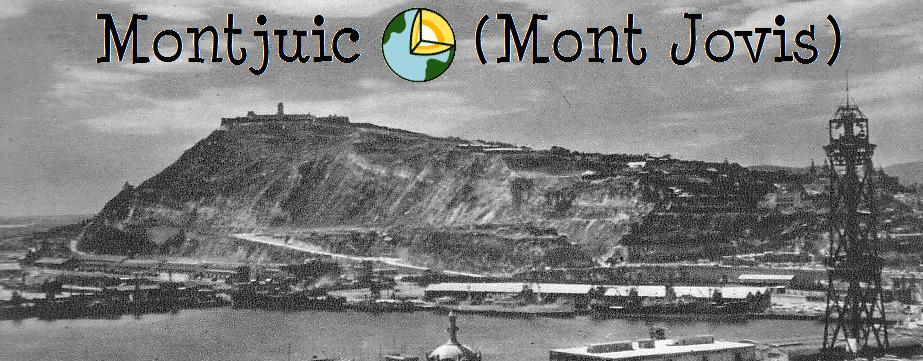
The city of Barcelona was born sponsored by two hills, Mount Taber and Mount Jovis.
The first was the cradle on which it grew. The second, currently called Montjuïc, has provided an important part of the raw material with which, since Roman times, has been built in Barcelona. Many of the classical buildings of Barcelona are made with the "Montjuïc stone", a compact, rugged stone, colors of white, red or violet. Just walk around the city, to see that many buildings (la Catedral, el Palau de la Virreina, el Parlament ...) carry the imprint feature of this mountain.
Despite the intense urbanization that has experienced Montjuïc this century, can still see the scars caused by the exploitation of ancient quarries ... resulting in semicircular walls of natural stone all around the mountain (la Foixarda, el Sot del Migdis, el Teatre Grec ...).
Workers to extract stone, classified in two varieties: white lead and rejection. The white lead is the cornerstone of good quality, hard and compact but easy to work. The rejection is of poor quality, splintery and unhelpful for construction. The sandstones of the Montjuïc fully silicificated (cemented by quartz and other varieties of the silica) and this provides a very hard stone, and the existence of white lead or rejection depends on the intensity of this silicificacion.
Montjuïc mountain consists of sedimentary rocks (clays, sandstones and conglomerates) deposited in a delta during the Miocene (15 million years ago), flows into the Mediterranean Sea. The materials came from the erosion of Collserola, so that today in the rocks of Montjuïc, there are pebbles all lithologies present in this massif (granite and slate).
La ciutat de Barcelona va néixer apadrinada per dos turons, el Mont Taber i el Mont Jovis.
El primer ha estat el bressol sobre el qual va créixer; el segon, anomenat actualment Montjuïc, ha subministrat una part important de la matèria prima amb la que, des de l'època dels romans, s'ha anat construint la ciutat de Barcelona. Molts dels edificis clàssics de Barcelona, són fets amb la "pedra de Montjuïc", una pedra compacta i resistent de coloracions blanques, vermelloses o violàcies. Només cal passejar per la ciutat, per veure que nombrosos edificis (Catedral, Palau de la Virreina, Parlament...) duen l'empremta característica d'aquesta muntanya.
Actualment, tot i la intensa urbanització que ha experimentat Montjuïc durant aquest segle, encara és possible observar les cicatrius deixades per l'explotació de les antigues pedreres, formant murs semicirculars de roca natural al voltant de tota la muntanya (La Foixarda, Teatre Grec...).
Els treballadors que extreien la pedra, la classificaven en dues varietats: blanquet i rebuig. El blanquet és la pedra de bona qualitat, dura i compacta però fàcil de treballar. El rebuig és la de mala qualitat, desagregable i poc útil per a construcció. Els gresos de la muntanya de Montjuïc estan completament silicificats (cimentats per quars i altres varietats de la sílice) i això proporciona a la pedra una gran duresa, així l’existència de blanquet o rebuig depèn de la intensitat d’aquesta silicificació.
La muntanya de Montjuïc està formada per roques sedimentàries (argiles, gresos i conglomerats) dipositats en un delta que, durant el Miocè (fa 15 milions d'anys), desembocava a la mar Mediterrània. Els seus materials provenien de l'erosió del massís de Collserola, de manera que, actualment, dins les roques de Montjuïc trobem còdols de totes les litologies presents en aquest massís (granits i pissarres).
Montjuïc mountain stands between the sea and the city. Located south of the city, is attached to a small hill on the coast, which protrudes from the plain of the Llobregat delta. Profile has a steep slope to the east and gentle slope to the west, has a maximum altitude of 191.7 m (Montjuïc Castle), and an approximate area of 360 ha.
The east slope of the mountain is near the Port of Barcelona, in the southern part of this slope, are the Montjuïc Cemetery, and the grounds of the former textile Factory Riviere SA. Towards the north, are the Lighthouse, el Mirador de l'Alcalde and gardens of Miramar, townhouses in the neighborhood of Poble Sec de Barcelona.
On the western side of the mountain, are the most ancient quarries. From south to north we find: el Fossar del Jueus, el Sot del Migdia, el Club de Natació Montjuïc, l’estadi Joan Serrahima, la Foixarda, el Tatre Grec, Santa Madrona, and el Mirador del Poble Sec. This is the most urbanized part of the mountain, it has built throughout the Barcelona Olympic Ring, the fairgrounds and the Palau Nacional and others. There is also the headquarters of the Institut Cartogràfic de Catalunya ICC.
La muntanya de Montjuïc s’alça entre el mar i la ciutat de Barcelona. Situada al sud de la ciutat, constitueix un petit turó adossat a la costa que sobresurt de la plana del delta del Llobregat. El seu perfil és escarpat al vessant est i suau al vessant oest, té una altitud màxima de 191,7 m (Castell de Montjuïc), i una extensió aproximada de 360 ha.
El vessant est de la muntanya està adossat al Port de Barcelona, a la part meridional d’aquest vessant es troben el Cementiri de Montjuïc i els terrenys de l’antiga fàbrica de teixits Riviere S.A. I cap a la part septentrional el Far, el Mirador de l’Alcalde i els jardins de Miramar adossats al barri del Poble Sec de Barcelona.
Al vessant oest de la muntanya es troben la majoria d’antigues pedreres. De sud cap a nord podem trobar: el Fossar dels Jueus, el Sot del Migdia, el Club de Natació Montjuïc, l’estadi Joan Serrahima, la Foixarda, el Teatre Grec, Sta. Madrona i el Mirador del Poble Sec. Aquest és el vessant més urbanitzat, ja que s’hi ha construït tota l’anella olímpica barcelonina, els recintes firals i el Palau Nacional entre altres. És també on té ubicada la seva seu el Institut Cartogràfic de Catalunya ICC.
GEOLOGICAL SITUATION SITUACIÓ GEOLÒGICA
The formation of Montjuïc became during the Miocene and is associated with a period of intense extension that caused the opening Balearic Sea (Valencia Groove).
Due to this extensive system was formed at the boundary of NW Valencia Groove, a rift (depressed area due to crustal extension) consists of several sedimentary basins of graben type (Vallès-Penedès, Barcelona ...) separated by structural elevation "Horst" (Collserola-Montnegre, Garraf ...), which form the current Catalan coastal ranges. The structure of this rift is dominated by normal faults oriented generally NE-SW to ENE-WSW.
In the central part of the Catalan coastal ranges, there are two semigrabens Neogene: the Vallès-Penedès and the Barcelona semigraben, the latter currently remains submerged beneath the waters of the Mediterranean. Both are separated by Horst Garraf and Collserola-Montnegre. Montjuïc is formed by sedimentary rocks (conglomerates, sandstones and clays) deposited in deltaic environment. Structurally, as swinging a small block located in the link between Horst Collserola-Montnegre and the semigraben and Barcelona.
La formació de Montjuïc esdevingué durant el Miocè i està associada a un període d’intensa extensió que provocà l’obertura del mar baleàric (Solc de València).
Degut a aquest règim extensiu es formà, al límit Nord Oest del Solc de València, un rift (àrea deprimida degut a extensió cortical) constituït per diverses conques sedimentàries de tipus graben (Vallès-Penedès, Barcelona...) separades per elevacions estructurals o horsts (Collserola-Montnegre, Garraf...), les quals formen les actuals Serralades Costaneres Catalanes. L’estructura d’aquest rift és dominada per falles normals amb orientació general Nord Est - Sud Oest a ENE-WSW.
A la part central de les Serralades Costaneres Catalanes hi ha dos semigrabens neògens: el semigraben del Vallès-Penedès i el semigraben de Barcelona, aquest darrer actualment roman submergit sota les aigües del Mediterrani. Ambdós estan separats pels horsts del Garraf i de Collserola-Montnegre. Montjuïc és format per roques sedimentàries (conglomerats, gresos i argiles) dipositades en ambient deltaic. Estructuralment, forma un petit bloc basculat situat a la zona d’enllaç entre el horst de Collserola-Montnegre i el semigraben de Barcelona.
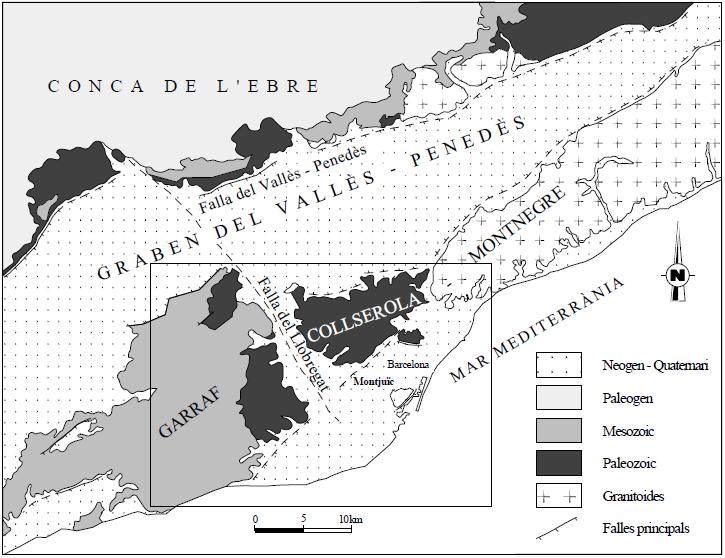
Age of materials and processes represented: Edat dels materials i processos representats:
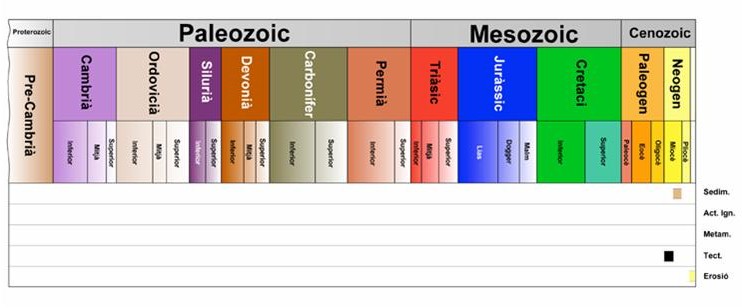
Status of Miocene lithostratigraphic units in Montjuïc Disposició de les unitats litostratigràfiques Miocenes
(A) 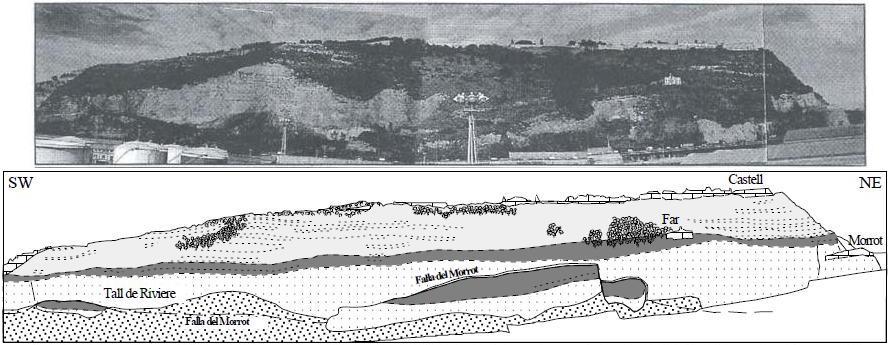 View SE side (click to enlarge)
View SE side (click to enlarge)
(B) 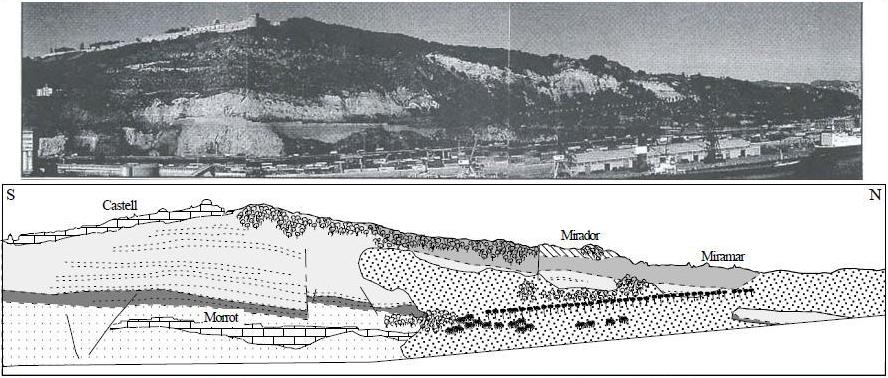 View E side (click to enlarge)
View E side (click to enlarge)
Situation of the two views (A and B)



Greek Theatre Teatre Grec
The Greek Theatre in Barcelona is an outdoor theater, although his name is not a construction made by the ancient Greeks. It was designed and built in 1929 for the "International Exposition in Barcelona" by the architects Ramon Reventós and Nicolau Maria Rubió i Tudurí, inspired by the floor of the theater of Epidaurus.
It was located in an old quarry on the mountain, so that cut into the stone wall serves as the theater scene.
Currently, almost all its activity is reduced in the summer months, when in late July and early August became the main stage of the Greek Festival, which just gave its name to mark its first edition in 1976. The rest of the year is an outdoor enclosure.
El Teatre Grec de Barcelona es un teatre a l’aire lliure, tot i el seu nom, no es tracta d’una construcció realitzada per els antics grecs. Va ser dissenyat i construït l’any 1929 amb motiu de l’Exposició Internacional de Barcelona per l’arquitecte Ramon Reventós i Nicolau Maria Rubió i Tudurí, que s’inspira en la planta del teatre d’Epidaure.
Es va ubicar en una antiga cantera de la muntanya, de tal manera que la paret excavada a la pedra serveix com a escena del teatre.
Actualment, gairebé tota la seva activitat es redueix als mesos d'estiu, quan entre finals de juliol i principis d'agost es converteix en l'escenari principal del Festival Grec, al qual precisament va donar nom amb motiu de la seva primera edició el 1976. La resta de l'any és un recinte a l'aire lliure.

Gardens of the Greek Theatre: Jardins del Teatre Grec:
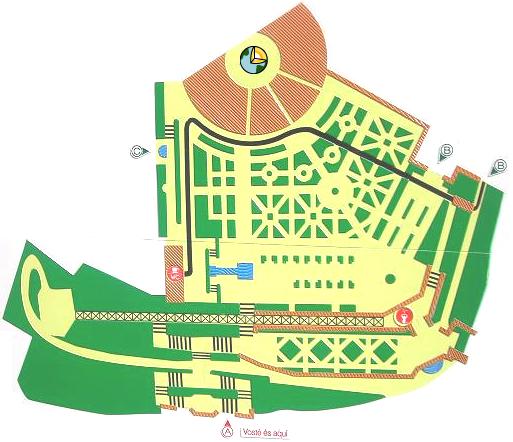
Visits: Pg.Santa Madrona (A) Laribal Gardens (B), Passage Martras (C) Hours: 10.00 am till dusk
Accessos: Pg.Santa Madrona (A), Jardins de Laribal (B), Passatge de Martras (C) Horari: de les 10.00h fins al capvespre
The entrance to the theater (old quarry) may be restricted during the Greek Festival (June and July) during the Mercè (patron saint of Barcelona) and other festivals and shows. During the rest of the year, access is free.
To see if you can or not access the Earthcache area, see in advance the following websites: www.bcn.cat/grec and www.bcn.cat/merce (info in Catalan, Spanish and English)
L'entrada al teatre (antiga cantera) pot estar restringit, durant el Festival Grec (juny i juliol), durant les festes de la Mercè, i altres festes i espectacles. Durant la resta de l'any, l'accés és lliure.
Per saber si podreu, o no, accedir a la zona del Earthcache, consulteu amb antelació les següents webs: www.bcn.cat/grec i www.bcn.cat/merce (info en català, castellà i angles)



Montjuïc Stone in the Sagrada Familia Temple: La Pedra de Montjuïc al Temple Expiatori de la Sagrada Família:
This was the first stone used on the construction of the church and the most emblematic. On the exterior, Montjuïc stone dominates the building, from the stone crib on the Nativity façade, which is said to be the largest ever constructed in the material, to the inclined columns of the Passion façade. It is known to have been used in Roman times. For town planning reasons the quarries on the mountain were closed in the second half of the 20th century. Since then the church has usedMontjuïc stone from demolitions, donations and stocks of material.
This stone is extremely hard. It is a detrital siliciclastic sedimentary rock. Mineralogically it is formed of angular pieces of quartz, feldspar, fragments of rocks (mainly metamorphic and granite) and minority minerals such as muscovite or tourmaline.
As far as the texture is concerned the large pieces are joined with microcrystalline silicic cement. In general, this rock may be classified as a silicic stone or a silicic litharenite, since it contains a high proportion of large lithics.
Va ser la primera pedra emprada en la construcció del temple i la més emblemàtica. A l'exterior, la pedra de Montjuïc domina el conjunt, des del pessebre de pedra a la façana del Naixement, que es diu que és el més gran construït en pedra, fins a les columnes inclinades de la façana de la Passió. Se sap que ja s'explotava en època romana. Per raons urbanístiques es van tancar les pedreres de la muntanya a la segona meitat del segle XX. Des d'aleshores el temple utilitza encara el gres de Montjuïc procedent d'enderrocs, donacions i reserves de material.
Aquesta pedra és un gres d'una gran duresa. És una roca sedimentària detrítica siliciclàstica. Mineralògicament està formada per grans angulosos de quars, feldspat, fragments de roques (principalment metamòrfiques i granítiques) i minerals minoritaris, com moscovita, turmalina...
Pel que fa a la textura, els grans estan units amb ciment silici microcristal·lí. Aquesta roca, en general, es pot classificar com un gres silici o una litarenita silícica, atès que conté una elevada proporció de grans lítics.




To validate this EarthCache: Per validar aquest EarthCache:
1] By registering the cache, you can take a picture with your GPS in these coordinates, and upload it with your registration.
Al registrar el catxé, us podeu fer una fotografia amb el vostre GPS, en aquestes coordenades, i penjar-la amb el vostre registre.
2] To answer the following questions: Contestar les següents preguntes:
- Approximate the height of the stone wall (the stage of the Greek theater) in meters.
Estimar l’alçada de la paret de pedra (l’escenari del Teatre Grec) en metres.
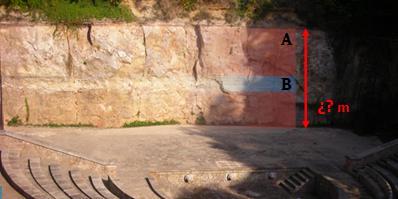 - Look carefully the wall, carved in stone (the old quarry). Each of the cracks, discolorations of the stone, or nails that hold it (to prevent further landslides). If vegetation is not covered, you can see along the wall: a strip [ B] formed by a type of stone, well differentiated from the rest of the wall [A].
- Look carefully the wall, carved in stone (the old quarry). Each of the cracks, discolorations of the stone, or nails that hold it (to prevent further landslides). If vegetation is not covered, you can see along the wall: a strip [ B] formed by a type of stone, well differentiated from the rest of the wall [A].
After reading the description of the cache, would you know say, which of the following types of stones is made each part [A and B]?
Slates; Sandstones (more or less silicificated); Basalts; Clays; Conglomerates; Granite
Observeu bé la paret excavada a la pedra (de l’antiga cantera). Cadascuna de les esquerdes, les decoloracions de la pedra, o els claus que la subjecten (per evitar noves esllavissades). Si no esta recoberta de vegetació, podreu veure al llarg de la paret: una franja [ B] formada per un tipus de pedra, ben diferenciada de la resta de paret [A].
Després de llegir la descripció del catxé, sabríeu dir, de quins dels següents tipus de pedres esta formada cada part [A i B]?
Pissarres; Gresos (mes o menys silicificats); Basalts; Argiles; Conglomerats; Granits
- What kind of rocks are the Granite? And Slate? (only a brief description)
Quin tipus de roques són el Granit? I la Pissarra? (Només una breu descripció)
- In the picture below, indicates what number (1 or 2) corresponds to a Graben, and what to Horst. Justify so. (only a brief description)
En la següent imatge, indica quin numero (1 o 2) correspon a un Graben, i quin a un Horst. Justifica-ho. (Només una breu descripció)

You must send the answers (in Catalan, Spanish or English). You can log it without waiting to receive my validating response.
Heu d'enviar les respostes (en Català, Castellà o Anglès). No cal esperar la meva resposta per fer el registre online.
I hope you enjoy this beautiful place. Espero que gaudiu d'aquest paratge.

